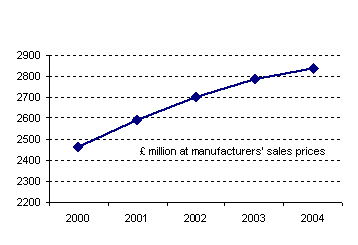The
authors of the report estimate that, at trade prices, the windows and doors fabrication
market grew by 3% in 2003 to around ?.8bn.

UK Door and Window Market, 2000 - 2004
During the mid-late 1990s, the overall growth
rate has largely been fuelled by strong performances in the domestic conservatory, curtain
wall, roof glazing and commercial windows sectors. The non-domestic market has been
relatively buoyant in the 2001-03 period, underpinned by high levels of construction
output in the commercial office, education and health sectors, though the domestic
replacement and housebuilding sectors have been less positive.
In particular, the residential windows and doors markets - with estimated shares of 27%
and 7% respectively - have been static during the last few years, although volumes have
been relatively steady. Prices and margins are under pressure throughout the distribution
chain, particularly for PVC-U, underpinned by intense competition and over-capacity,
especially within the direct sell market. In the residential windows and doors markets,
growth opportunities are becoming increasingly limited as the replacement sector is very
mature, especially in the home-owning sector. The newbuild market is relatively small by
comparison, and so the anticipated upturn in the housebuilding market is unlikely to
offset growing pressure on the replacement sector.
Conservatories continue to offer good prospects in the domestic sector, with strong growth
in 2001-03. Rising interest rates in late 2003/early 2004 may have an adverse impact on
this sector, but market penetration is low and the product remains high on homeowners
preferences for home improvements.
Health and education have provided major market opportunities in the last 3 years, and are
forecast to experience further growth in the medium term. However, the next General
Election in the UK is likely to be held by Summer 2005, which may result in a slowdown in
capital expenditure in the pubic sector if a Conservative Government is elected. Growth in
the public sector will generate increased demand for aluminium and PVC-U commercial
windows and low-rise curtain wall. The commercial office sector, which has recorded
positive growth over a number of years, has, however, suffered a downturn in 2002-04 and
this will affect demand for windows.
The supply sector is very fragmented as it comprises vertically integrated retail glazing
companies, PVC-U systems trade fabricators and fabricator/installers, aluminium systems
fabricator/installers, bespoke glazing contractors, composite door manufacturers,
commercial glazed door manufacturers, rooflight manufacturers, steel window manufacturers
and major joinery companies.
The industry is highly competitive and while there has been some consolidation, there is
still likely to be further rationalisation. In particular as the domestic replacement
market matures, there are likely to be companies exiting the industry and or further
mergers/acquistions. The retail glazing sector is itself very fragmented, the leading 7
suppliers only having a combined market share of around 30%, led by Anglian .
The PVC-U trade fabrication is also highly fragmented, with leading players such as
Shepley, Speedframe, Griffin Windows, Sash UK, Coastal, CWG -Corby Windows Group and John
Fredericks etc. typically having shares of 1-3% of the domestic doors and windows market.
The growing number of 'super-fabricators' is leading to gradual consolidation, as is the
fact that a number of smaller fabricators are withdrawing from manufacture to focus on
installation. In 2003, Shepley Windows acquired Interframe Ltd, the Paignton based trade
fabricator. The combined turnover of the two operations is around ?0 million, which makes
it the largest player in the sector.
The aluminium fabrication industry is largely focused on the non-domestic market, as the
use of aluminium in the domestic sector has lost share to PVC-U alternatives. In recent
years, this sector has been marked by a large loss of capacity with around 10 major
players no longer in operation. There are no dominant companies in this sector, but key
players include: Solaglas, AC Yule, Parry Bowen, Dane Architectural Systems, SLW, CAP
Aluminium and Charles Henshaw.
The other key supplier sector is the joinery industry, largely selling timber windows and
doors to the builders merchants and DIY markets, although the leading players have
diversified into PVC-U and composite materials as demand for timber products has declined.
Key suppliers are Magnet, Jeld-wen
UK , Premdor etc.
In terms of
materials, PVC-U is considered to have reached its peak in many markets, particularly the
domestic market. Aluminium has a particularly strong share of the commercial market,
however, where its strength makes it suitable for structural glazing projects. Timber,
whilst losing share in the past, has retained a share of the market, helped by some HA/LA
specification of timber for doors and windows, advances in timber treatments and the
traditional appeal of wood.
For more information about this report click
http://wood-info.com/1103.htm